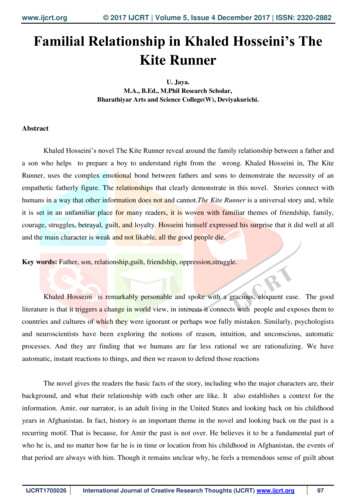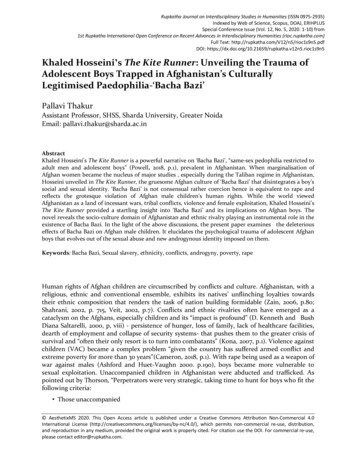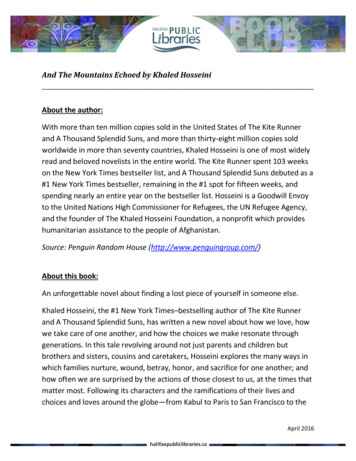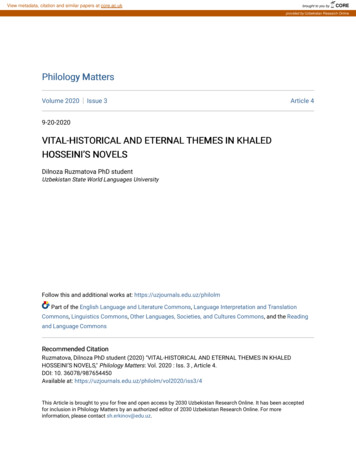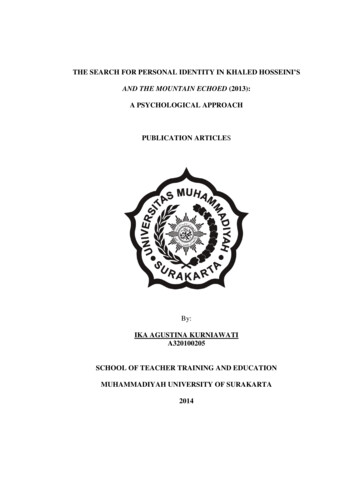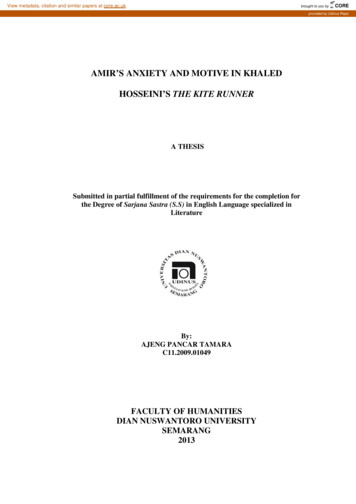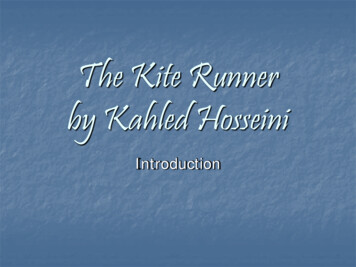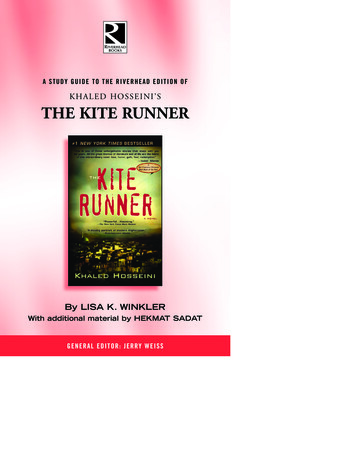
Transcription
A S TU D Y G UIDE TO THE RIVERHEAD E DITION OFK H A L E D H O S S E I N I’STHE KITE RUNNERBy LISA K. WINKLERWith additional material by HEKMAT SADATG E NERAL EDITOR: JERRY WE IS S
2A Study Guide to Khaled Hosseini’s The Kite RunnerTABLE OF CONTENTSIntroduction .3Summary .3About the Author .3A Historical Overview of Afghanistan.4Before Reading.5Introduction to the Study Guide .5During Reading .6Vocabulary Activities.6Reading Questions, Quotations, & References .6Themes .6General Reading Response Topics .6Chapters 1-5 .7Chapters 6-9 .9Chapters 10-14 .10Chapters 15-20 .12Chapters 21-25 .13After Reading Activities .15Additional Resources.16About the Authors and Editor of this Guide .17Full List of Free Teacher's Guides.18Click on a Classic .19Dedication: To Dr. M. Jerry WeissCopyright 2007 by Penguin Group (USA)For additional teacher’s manuals, catalogs,or descriptive brochures, please emailacademic@penguin.com or write to:PENGUIN GROUP (USA) INC.Academic Marketing Department375 Hudson StreetNew York, NY 10014-3657www.penguin.com/academicIn Canada, write to:PENGUIN BOOKS CANADA LTD.Academic Sales90 Eglinton Ave. East, Ste. 700Toronto, OntarioCanada M4P 2Y3Printed in the United States of America
A Study Guide to Khaled Hosseini’s The Kite Runner3INTRODUCTIONSUMMARYThe Kite Runner, spanning Afghan history from the final days of the monarchy tothe present, tells the story of a friendship between two boys growing up in Kabul.Though raised in the same household and sharing the same wet nurse, Amir andHassan grow up in different worlds: Amir is the son of a prominent and wealthyman, while Hassan , the son of Amir's father's servant, is a Hazara. Their intertwinedlives, and their fates, reflect the eventual tragedy of the world around them. Whenthe Soviets invade and Amir and his father flee the country for a new life inCalifornia, Amir thinks that he has escaped his past. And yet he cannot leave thememory of Hassan behind him.ABOUT THE AUTHORBorn in Kabul, Afghanistan, in 1965, Khaled Hosseini moved to Tehran in 1970,where his father worked fro the Afghan embassy. Returning to Kabul in 1973, hisfather continued as a diplomat with the Afghan Foreign Ministry and his mothertaught Farsi and history at a high school. In July of 1973, the night Hosseini’syoungest brother was born, the Afghan king, Zahir Shah, was overthrown in abloodless coup by the king’s cousin, Daoud Khan. At the time, Hosseini was infourth grade and was already drawn to poetry and prose; he read a great deal ofPersian poetry as well as Farsi translations of British and American novels.In 1976, the Afghan Foreign Ministry relocated the Hosseini family to Paris. Plansto return to Kabul in 1980 were thwarted by the bloody communist coup andsubsequent invasion of the Soviet army. Granted political asylum by the UnitedStates, they moved to San Jose, California, in September 1980. Having lost all theirproperty in Afghanistan, they lived on welfare and food stamps while Hosseini'sfather worked multiple jobs to become financially stable. Hosseini graduated fromhigh school in 1984 and enrolled at Santa Clara University where he earned abachelor’s degree in biology in 1988. The following year, he entered the Universityof California-San Diego’s School of Medicine, where he earned a medical degree in1993. He completed his residency at Cedars-Sinai Hospital in Los Angeles.Though Hosseini has practiced internal medicine since 1996, he yearned to write. Hismemories of the peaceful pre-Soviet era Afghanistan led him to write The Kite Runner,as well as his personal experiences with Afghan Hazaras, a shunned ethnic minority.While living in Iran, Hosseini, in third grade, taught a 31-year-old Hazara man toread and write.
4A Study Guide to Khaled Hosseini’s The Kite RunnerA HISTORICAL OVERVIEW OF AFGHANISTANBY MIR HEKMATULLAH SADAT, PH.D.Afghanistan’s main ethnic composition includes the Pashtun, Tajik, Hazara, Uzbek,Baluchi, and Turkoman people. The Afghan nation is a very heterogeneous population,comprising at least 22 languages, of which Dari and Pashto are officially recognizedin the constitution. Practically everyone in Afghanistan is Muslim representing bothSunni and Shia Muslims. The majority of Hazaras and Qizilbash are Shia, while themajority of Pashtun, Tajik, Uzbek, Turkoman, and Baluchi people are Sunni. Untilrecent times, other religions were also represented in Afghanistan. In Kabul and ina few other urban cities, exclusive communities of Hindus, Sikhs, and Jews coexisted within the Muslim population. Like similar societies, Afghan traditions havebeen preserved because of the prevailing influence of religious customs and tribalculture. In Afghanistan, the Pashtuns are the last ethnic group still having anoperational tribal system, known as Pashtunwali (Code of the Pashtuns). However,the Pashtuns are divided into hundreds of tribes and clans. Nonetheless, all Afghanethnic groups have been able to preserve their kinship, village, and regional ties.The country has inherited a rich linguistic and cultural heritage dating back thousandsof years. Afghanistan is a mountainous, arid and landlocked country often called the‘heart of Asia’, sharing borders with Pakistan, Iran, Tajikistan, Uzbekistan, Turkmenistan,and China. Not only has the geographic location of Afghanistan been importantstrategically, but it was also a highway for trade, raids, and military marches.Afghanistan emerged as a nation-state in the 18th century after centuries of invasionsbegins in 1973, when the army overthrew the monarchyand conquests.led by Zahir Shah. He was forced into exile in Italy by his cousin and son-in law,Daoud Khan, who declared himself president of the republic. Daoud Khan spokeabout ending corruption and being true to the revolution but it became apparentthe regime change was only a transfer of power. Resistance against the new regimeformed immediately by Islamic guerrilla rebels. By 1975, the regime began purgingfrom the government all officials with socialist or Marxist ties. After a series of socialistleader assassinations, Daoud Khan was overthrown by the same military that broughthim to power. The coup brought to power two factions of a socialist organization inwhat would be described as the April Revolution. From April 1978 until December1979, the Khalq (Masses) faction led by Nur Muhammad Taraki and HafizullahAmin forced socialist reforms which incited the tribal and religious institutions torevolt. Various resistance groups united along one front called the mujahidin (holystrugglers) and declared a jihad (holy struggle) against the Afghan state.Fearing the fall of the pro-Soviet regime in Afghanistan, the Soviet Union invadedAfghanistan in December 1979. Returned from exile was Babrak Karmal, head of theParcham (Banner) faction, who quickly announced general amnesty for political prisonerswhich included prominent mujahidin leaders and invited moderates to cooperate inthe reconciliation. However, Karmal’s measures were damaged by the brutal militaryoperations of the Red Army and misuse of power by certain Afghan bureaucrats. Inaddition, the billions of covert military aid provided by the United States, Saudi
A Study Guide to Khaled Hosseini’s The Kite Runner5Arabia and other countries to the mujahidin escalated the war and reduced anychances for an Afghan reconciliation.In 1986, Dr. Muhammad Najibullah, head of the notorious secret service, replacedKarmal. After a decade, the Soviet army withdrew, leaving the state split among manyethnic factions. In 1992, the mujahidin takeover of the state ignited into a civil warbetween mujahidin warlords, and later between the warlords and the Taliban. In the 1990sthe Taliban assumed control and introduced strict adherence to Islamic law. Between 1992and 2001, Afghanistan became the site for the worst battles, ethnic genocide, pillage,famine, and misery since Genghis Khan had swept through the region centuries earlier.The terrorist group, Al Qaeda, led by Osama bin Laden, had also built training campsin Afghanistan. While most of the world condemned the Taliban, they were officiallyrecognized by three countries: Pakistan, Saudi Arabia, and the United Arab Emirates.After September 11, 2001, the Taliban refused to hand over Bin Laden, leading to a U.S.led coalition military campaign. By November, 2001, the Taliban lost control of Kabul.A new government, the Transitional Islamic State of Afghanistan was established inDecember 2001. Assisted by the international community, the Afghan state is tryingto rebuild the war-torn nation, as well as establish economic and political stability.Despite its efforts, the Afghan government faces the same obstacles as faced by thegovernment during the Soviet presence in Afghanistan. While President HamidKarzai and prominent members of his cabinet and the elected parliament call forreconciliation and ceasefires with the Taliban; internal discord in the government,misuse of donor aid, bribery and corruption of state officials, the drug trade,promotion of warlords, the inability to control the untamed military campaigns offoreign troops such as collateral damage, the inability to understand the culture andcustoms of Afghans, and support for the Taliban resistance across the border inPakistan has stymied any hopes for democratization and peaceful reform.BEFORE READINGINTRODUCTION TO THE STUDY GUIDEStudents would benefit by knowing about Afghanistan's history and cultures. Pre-readingactivities could include researching more in depth about the nation's geography,history, politics, and religions. Afghanistan's volatile political situation are covered bynews organizations. Many resources are available in libraries and on the internet.The study guide is organized for you, the teacher, to use and adapt as needed for yourstudents. The novel is divided into segments of several chapters, providing readingassignments, and each section includes reading questions, vocabulary words, referencesthat you might choose to explain to students, or have them research, and quotations.The list of themes can be discussed as you read or at the conclusion. They provideopportunities for students to make connections to other works of literature they'veread, movies or theater they've seen, and other events in history or current day. Thegeneral reading response topics can be used for journal writing. The creative projectscan be used to extend the reading experience and promote critical thinking.
6A Study Guide to Khaled Hosseini’s The Kite RunnerDURING READINGVOCABULARY ACTIVITIESThere's a selection of vocabulary words identified for each reading section. You maywant to either add to this list or decrease it depending on your students. You candecide whether to introduce vocabulary before reading the section, during, or after.Vocabulary activities could include looking up definitions, writing originalsentences, finding the words on the pages and making a guess based on context cluesand so on. You can quiz students on each section of words, assign them to write theirown stories with vocabulary words, or play games to reinforce word meanings.READING QUESTIONS, QUOTATIONS & REFERENCESThe reading questions can be assigned as homework, to complete during or afterreading, and can be used as starting points for classroom discussion. As you readeach chapter, look for sections that might lend themselves to readers' theater, actingout, or debates. Encourage students to look for news articles about Afghanistanwhile you're studying the novel. You can have students do mini-research projects onthe various references from the novel that are mentioned in the guide. Students canpresent their findings to the class in the form of oral reports. The quotations can beassigned as writing topics or used to spur classroom discussion.THEMESThese themes can be discussed while reading the novel and at its conclusion. They canbecome sources for essay writing, reading connections, and classroom discussion. BullyingRole of books, literacyFriendship, guilty & redemptionFathers & sonsComing of AgeResilience of the human spiritMan's inhumanity to manDiscrimination, prejudice, bigotry, class structureMaster/slave relationships: loyalty & devotion vs. dutyGENERAL READING RESPONSE TOPICSOne way to assist students in finding more meaning in their reading is throughresponse journals. You can assign topics or allow students to select their own. Thesecould be a "do now" activity in the beginning of class.1.Connections: text to text, text to self, text to the world. Compare and contrastyour book to others you’ve read, to situations or people in your own life, toevents in history or the news.
A Study Guide to Khaled Hosseini’s The Kite Runner72.Characters: Do you like the main characters or not? Why? Do you have anyadvice for them? Comment about the narration. Who’s telling the story?3.Social questions: Looks for race, gender, or class inequalities and injustices.Who has the power in the story and how is it used? What do you think?4.Setting: Is it realistic? Does it fit the story?5.Dialogue: Is it realistic? Can you “hear” the characters talking? Could youchange the dialogue?6.Emotions: How were you emotionally involved in the story?7.Literary devices: Does the author use flashbacks and foreshadowing effectively?8.Themes: To what extent is this a morality tale?9.Ending: Would you have liked the book to end differently? How?I. CHAPTERS 1-5 (PP. 1-47)READING QUESTIONS1.The novel begins with a flashback.What do you think is its purpose? What doyou learn about the narrator?2.Who is Hassan? Describe him physically. What is a cleft lip? Describe him byhis relationships. What was his first word? Why is that important? How did hecome into Amir's life? What contrast is made between Amir and Hassan?3.What does it mean to be Hazara, Shi’a Muslim, Afghanistan’s minority group?Who, in the story thus far, is Hazara?4.What does it mean to be Pashtun, Sunni Muslim, Afghanistan’s majority group?Who, in the story thus far, is Pashtun?5.How does Amir describe his home? Why do you think he elaborates this descriptionso much? What do the details of the family pictures in Amir's house reveal?6.Who is Sanaubar? How is she contrasted to Amir's mother?7.Who is Ali? What do the neighborhood children call him? What does it mean?Why do they call him this?8.How does Amir feel about his father in these chapters?9.Who is the king’s cousin? What did he do and why?10. Who is Baba? Describe him. What are his values? How does he relate to extremelyreligious leaders?11. What does Baba give Hassan for his birthday? What does his present suggestabout his character? How does Amir react to this present? Why did the presentturn out to be ironic?12. Who is Assef? What is his ancestry? What is he famous for? What is his politicalvision?
8A Study Guide to Khaled Hosseini’s The Kite Runner13. Who are Wali and Kamal?14. What happens between Assef/Wali/Kamal and Amir/Hassan? What does Assefthreaten (foreshadow)?15. Hassan has plastic surgery to be able to smile “normally” by the following winter.Why does Amir think that is ironic?16. What does Amir want to tell Assef about Hassan when Assef bullies them aboutbeing friends?VOCABULARY CHAPTERS 1-5Affluent, intricate, p. 4Notoriously, unscrupulous, congenital, rendered, oscillating, reveries, p. 8Garrulous p. 10Veracity, p. 23Obstinate, p. 13Havoc p. 14Virtuous p. 15Chortle, p. 17Aloofness, p. 19Melee, p. 20Valiant, p. 21Contrite, impeccable, vehemently, p. 24Imbecile, p. 28Nemesis, p. 29Oblivious, p. 30Feigned, p. 31Irony, p. 32Subtle, nuances, p. 42Trepidation, p. 43REFERENCES:Henry Kissinger, p. 21Steve McQueen, Bullitt, p. 27Zahir Shah, fall of Afghan monarchy July 1973, p. 36QUOTATIONS"There is only one sin, only one. And that is theft. Every other sin is a variation oftheft." (p. 17)"A boy who won't stand up for himself becomes a man who can't stand up toanything." (p. 22)" a person who wastes his God-given talents is a donkey." (p. 32)
A Study Guide to Khaled Hosseini’s The Kite Runner9II. CHAPTERS 6-9 (PP. 48-109)READING QUESTIONS1.Why do boys in Afghanistan during the winter of 1975 have gashes on theirfingers? What is tar?2.In chapter 6, how does Amir feel about Hassan? (Think about his conflictedfeelings.) Why does he mean "my life as a ghost"? p. 563.What is the proudest moment of twelve-year-old Amir’s life as described inChapter 7?4.What happens to Hassan when he runs the blue kite for Amir? (Assefforeshadowed this earlier in Chapter 5.)5.Who says, “I opened my mouth and almost said something The rest of my lifemight have turned out differently if I had.” Why are those words important?What do you think of Amir's behavior?6.What is the significance of the two memories and dream presented on pages73-74?7.Where does the family take a trip to in Chapter 8?8.What does Amir ask of Baba that makes Baba angry? What does Baba say inresponse?9.What is inscribed on the pomegranate tree in the back yard? So, why then is itsignificant that Amir tries to pick a fight with Hassan in front of that tree?(Think symbolism.) What ends up happening? Why is that symbolic?10. What does Assef give Amir for his birthday? Why is this significant?11. What does Amir put under Hassan’s mattress? Why does he do it? What is yourreaction to Amir's betrayal?12. When Baba confronts Hassan about this, what does Hassan say?13. What does Baba then do that shocks Amir?14. What happens to Hassan and Ali?15. How is the end of chapter nine a turning point in the novel?VOCABULARY CHAPTERS 6-9Abhor, p. 52Indignation, p. 54Integrity, p. 54Curtly p. 60Shirked, austere, morose, p. 61Havoc, p. 75Imminent, p. 77Guileless, p. 78
10A Study Guide to Khaled Hosseini’s The Kite RunnerInsomniac, p. 86Harried, p. 91Anonymity, p. 93Interlude, p. 93Embodiment, p. 96Façade, p. 97Alter ego, p. 98Blood money, p. 102Grimace, p. 107QUOTATIONS"Afghans abhor customs but cherish rules." (p. 52)"But better to get hurt by the truth than comforted with a lie." (p. 58)"In the end, the world always wins. That's just the way of things." (p. 99)III. CHAPTERS 10-14 (PP. 110-194)READING QUESTIONS1.What “weakness” of Amir’s does Baba have to apologize for in Chapter 10?2.Who is Karim?3.Why are Amir and his father fleeing Afghanistan?4.Why does Baba challenge the Russian officer who is obviously high on drugs?5.In Chapter 10, several things happen that are ironic or foreshadowing. Labeleach one of these and explain: The only way Amir can survive the long ride in the fume-filled tank is byremembering flying kites with Hassan. Baba gathers up the dirt of his homeland and places it next to his heart. Kamal’s father commits suicide after Kamal dies from breathing the fumes ofthe tank. Kamal, one of Hassan’s rapists, has been raped himself and hasn’t spoken since.6.Chapter 11 has a new setting. What is it?7.“America was different. America was a river roaring along, unmindful of thepast. I could wade into this river, let my sins drown to the bottom, let thewaters carry me someplace far.” This quote from Chapter 11 is said by whom?What does it reveal? What does this metaphor mean?8.What does Baba give Amir as a graduation present? What is Amir feeling at thismoment? What is Baba feeling?9.In Chapter 11, who is Soraya?10. What are Baba and Amir doing in San Jose on the weekends?
A Study Guide to Khaled Hosseini’s The Kite Runner1111. Who is General Taheri?12. What does Amir tell his father he wants to study in college? What is Baba’sreaction?13. Baba observes that “It may be unfair, but what happens in a single day canchange the course of a whole lifetime.” Whom is he speaking about? Why?What else might be significant about that quote?14. What does Amir observe about a double standard in Chapter 12?15. Why did the visit with the pulmonologist become unsuccessful when Babaasked where he was from?16. What is Baba diagnosed with? How does he decide to treat it?17. Why does Amir asks Baba to meet with General Taheri?18. In Chapter 13, Amir thinks about the “bears” his father has wrestled during hislifetime. What “bears” has Baba wrestled?19. What good news does Amir learn in Chapter 13?20. What disappointment do Soraya and Amir face? Do you think Amir shouldhave told Soraya about his betrayal of Hassan before they were married? Whyor why not? What does this do to a relationship?21. In 1989, what is going on in Afghanistan? Who are the Mujahedin? Who is incharge?22. Chapter 14 brings us back to the opening of the book: the telephone call fromRahim Khan. What is Rahim asking Amir to do?VOCABULARY CHAPTERS 10-14Lucrative, p. 111Inevitable, p. 113Acrid, p. 132Pungent, p. 133Sauntered, p. 138Legacy, p. 140Arrogant, p. 140Perpetually, p. 144Fickle, p. 148Sallow, p. 153Ominous, p. 155Palliative, p. 156Reticence, demeanor, furtive, p. 157Daunting, p. 184Meticulous, ambivalent, p. 186Oblivious p. 188
12A Study Guide to Khaled Hosseini’s The Kite RunnerREFERENCES:Jimmy Carter, p. 126, Russian history, p. 126, world events, p. 183-4, - in 1989QUOTATIONS"Not a word passes between us, not because we have nothing to say, but because wedon't have to say anything—that's how it is between people who are each other'sfirst memories " (p. 122)"Baba loved the idea of America. It was living in America that gave him an ulcer."(p. 125) Comment on this paradox."For me America was a place to bury memories. For Baba, a place to mourn his."(p. 129) How can a place or moving bury memories?"People need stories to divert them at difficult times." (p-. 139)"Life is a train. Get on Board." (p. 185)IV. CHAPTERS 15-20 (PP. 195-258)READING QUESTIONS1.In Chapter 15, Amir meets with the dying Rahim Khan. Where are they?2.What does Amir say about clichés? Why does Amir use the cliché about "anelephant in the room" to describe his meeting with Rahim Khan?3.Afghanistan has been seized by what political group in Chapter 15?4.In Chapter 16, Rahim tells us what happened to Hassan. What has happened?Where is he living?5.Who is Farzana? Sohrab?6.What happened in 1996 by the Taliban in Mazar-i-Sharif?7.In Chapter 17, Rahim gives Amir a letter from Hassan, who wrote it six monthsbefore. What is the tone of this letter? How does Amir react?8.In Chapter 18, Amir finds out that both Hassan and his wife were shot by theTaliban trying to protect Baba’s house, orphaning their son. Rahim tells Amirit is his job to find Sohrab in Karteh-Seh, Afghanistan, and take him to anorphanage in Peshawar, Pakistan. What is Amir’s reaction? Do you thinkRahim's dying wish is unfair? Why or why not?9.How does the cliché, "like father, like son" mentioned on page 226, relate toBaba and Amir?10. What clues hint at the secret that is revealed in Chapters 17-18?
A Study Guide to Khaled Hosseini’s The Kite Runner1311. In Chapter 19, Farid is engaged to drive Amir from Peshawar to Afghanistan.Describe his first impression of Amir. When Farid said, "You've always been atourist here, you just didn't know it," (p. 232), what did he mean? What isFarid's impression of emigrant Afghans who return to visit Afghanistan?12. What realizations does Amir come to in Chapter 19?13. In Chapter 20, Amir sees Kabul for the first time since leaving. Describe whathe sees.14. In Chapter 20, the director of the orphanage, Zaman, tells Amir that Sohrabwas taken by a Taliban official, who takes children, usually girls, about once amonth, for his “sexual pleasure.” The official gives Zaman a great deal of cash.How does Zaman defend his actions?VOCABULARY CHAPTERS 15-20Nonchalantly, p. 195Incessant, p. 195Garrulous, p. 196Collateral, p. 200Melancholic, wallow, pragmatic p. 201Presumptuous, p. 207Proverbial, p. 212Oblivion, p. 226Empathy, p. 228Animosity, p. 228Surly, p. 229Rueful, p. 229Deliberate, ruminate, p. 231Contemptuous, p. 236Furtive, p. 238Morosely, p. 244Benevolence, p. 248Profoundly, p. 250QUOTATIONS"A boy who won't stand up for himself becomes a man who can't stand up toanything." (p. 221)V. CHAPTERS 21- 25 (PP. 259-371)READING QUESTIONS1.In Chapters 21-22, the cruelty of the Taliban is clearly in evidence. Give twoor three examples.
14A Study Guide to Khaled Hosseini’s The Kite Runner2.In Chapter 21, Amir finally sees Sohrab and realizes something about theTaliban official. What is it? What is your reaction to Assef's reappearance as aTalib? How does he justify his transformation? Is it a transformation?3.In Chapter 22, we encounter many “full-circle” endings as we reach the climax,or turning point, of the plot. List three.4.What is your reaction to Rahim Khan's letter to Amir? Should the letter havebeen presented to him earlier? Do you feel that Baba was a good man?5.Consider your parents and how your opinions about them have changed as youhave gotten older. Are there any parallels between your concept of your parentsand Amir's concept of Baba?6.Chapter 24 continues the falling action of the plot. Why do Sohrab and Amirtravel to Islamabad? Amir says "There are a lot of children in Afghanistan, but littlechildhood." What does he mean? How can yo relate this to Hassan and Sohrab?7.What is a mullah?8.Who is Raymond Andrews and how does he function in the novel?9.What does Soraya agree to do?10. What does Soraya’s Uncle Sharif do to help Sohrab?11. What promise does Amir break to Sohrab?12. What then does Sohrab do? Why is this significant?13. Chapter 25 resolves the action with Sohrab and Amir returning to San Francisco.Describe Sohrab for the first seven months he is in San Francisco.14. General Taheri is worried about something when he comes to visit. What is it?What is Amir’s reaction to this?15. Why do Afghans gather at Lake Elizabeth Park?16. What happens as Amir runs the kite for Sohrab?17. How is this another full circle?VOCABULARY CHAPTERS 21-25Gingerly, p. 261Succulent, p. 265Morbidly, p. 275Surreal, p. 281Epiphany, p. 282Impunity, p. 301Remorse, p. 302Shrewd, p. 304Pondered, p. 306Paunchy, p. 308Reproachful, obligatory, p. 316Irrevocably, p. 320
A Study Guide to Khaled Hosseini’s The Kite Runner15Squalid, p. 329Fabricated, p. 330Reputable, p. 331Turmoil, p. 356Profusely, p. 357REFERENCESLes Miserables, p. 328; September 11, 2001- p. 36QUOTATIONS"A man who has no conscience, no goodness, does not suffer." (p. 301)"Perspective was (is) a luxury when your head was (is) constantly buzzing with aswarm of demons." (p. 356)AFTER READING AVTIVITIESExtending the reading experience for students, through a creative project, makes thereading more memorable and empowers students to have some ownership of theirwork. Many activities can be done in small groups.1.Write a diary of one of the characters. Tell his/her secret thoughts, motivations,history, ideas for the future, and thoughts about others.2.Rewrite part of the novel in poem or song form.3.Pretend you’re one of the characters. It’s 20 years from the end of the novel.Write a letter to another character in the book about what you’ve been doingwith your life.4.Write a series of letters between any two characters.5.Write a letter to the author about what you think about the book. (Mail oremail the letter)6.Based on research, write news articles or create a newspaper about a section ofthe novel. Create a timeline of world events.7.In a group, select a chapter or scene to dramatize. Write a script, designcostumes and props, and perform for the class.8.Write interview questions for the author and /or for the main characters.Pretend you're a talk show host and have invited the characters to speak. Stagethe show before the class.9.Write a sequel (or the next chapter) of the novel.10. Read another book about Afghanistan (see resources) and write a compare/contrastessay. How do different time periods influence the plots of the novels?
16A Study Guide to Khaled Hosseini’s The Kite Runner11. Select music to accompany different scenes from the novel. Explain why eachsong represents that particular scene.12. Choreograph a dance for a particular scene.13. Create a mural depicting a chapter or scene from the novel.14. Research an aspect of Afghan culture and present to the class. Include a visualsuch as a poster or travel brochure.15. Make kites (or purchase) and try to fly them!ADDITIONAL RESOURCESWEBSITESAzad, F. (2004). Dialogue with Khaled Hosseini.Lemar-Aftaab, 3(4), June. Retrieved January 10, 2005, fromhttp://afghanmagazine.com/2004 06/profile/khosseini.shtmlSadat, M.H. (2004). Afghan History: kite flying, kite running and kite bannin
A Study Guide to Khaled Hosseini's The Kite Runner 5 Arabia and other countries to the mujahidin escalated the war and reduced any chances for an Afghan reconciliation. In 1986, Dr. Muhammad Najibullah, head of the notorious secret service, replaced Karmal. After a decade, the Soviet army withdrew, leaving the state split among many ethnic .
